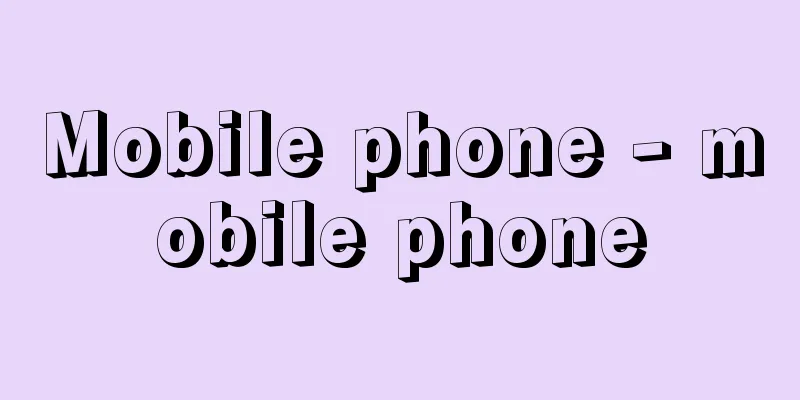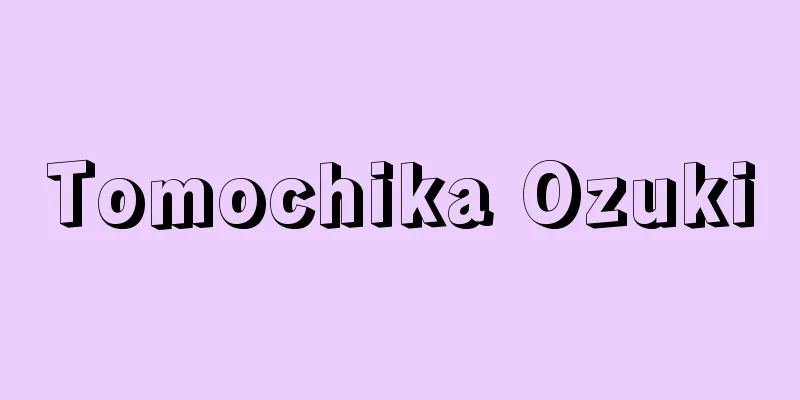Mobile phone - mobile phone

|
A small, portable information terminal that uses radio waves as a transmission medium. Its main functions include voice and video calling, text and image email, and data communication functions for browsing web pages including video, making it possible to realize "mobile communications." It is commonly called "mobile phone" and can also be written as "keitai" when writing. When referring to relatively high-function mobile phones that are not smartphones, they are sometimes called "feature phones." High-function mobile phones that have evolved uniquely in Japan are called "Galapagos mobile phones," or "garakei" for short, in reference to the creatures of the Galapagos Islands (which evolved uniquely because they are isolated islands). [Chisato Kobayashi] HistoryMobile phones are divided into four generations according to the communication method. First GenerationThe first generation was mainly voice communication via analog communication, and the world's first mobile communication was the car phone, which was introduced in St. Louis, USA in 1946. In Japan, car phone service began in 1979 (Showa 54). As a portable phone, the 3kg "shoulder phone" was released by NTT (Nippon Telegraph and Telephone Corporation) in 1985. Mobile phone service (NTT large capacity system) was launched in 1987, and the TACS (Total Access Communication System) system was launched by Japan Mobile Communications (IDO, now KDDI) in 1989 (Heisei 1). The NTT large capacity system and the TACS system use FDMA (Frequency Division Multiple Access, a frequency division multiple access system that divides users by frequency) technology. [Chisato Kobayashi] Second GenerationIn the 1990s, communication methods changed from analog to digital, and email and text information viewing functions were added to the existing voice calls. The main feature of the second generation is that the miniaturization of devices led to their provision as information devices for individuals. In Japan, the PDC (Personal Digital Cellular) service started in the Tokyo metropolitan area in 1993, while the PHS (Personal Handyphone System) service, which realized low-cost data communication, started in 1994. Overseas, the GSM (Global System for Mobile communications) system was adopted in more than 100 countries, mainly in Europe. Both PDC and GSM use the TDMA (Time Division Multiple Access) technology, which separates users by shifting the time, but they are not compatible. At the same time that mobile phones became personal possession, the use of email became widespread. With the launch of services such as "i-mode" and "EZweb" for mobile information distribution in 1999, the mobile content industry expanded rapidly, and email became the main function of mobile phones rather than voice calls. [Chisato Kobayashi] Third GenerationIn 2000, J-Phone (later Vodafone, now Softbank Mobile) released a mobile phone with a camera (Sha-mail), which became popular as a service that anyone could enjoy, allowing a visual approach to communication rather than text-based communication. In 2001, NTT DoCoMo introduced "FOMA" using the W-CDMA (Wide Band Code Division Multiple Access) system, and in 2002, au adopted the cdma2000 system, ushering in the third generation. With the increased communication speed of third generation mobile phones, it became possible to use not only still images but also videos such as "movie mail" and "videophone". In 2003, a flat-rate system was introduced, allowing users to use the service without worrying about communication charges, which greatly accelerated the spread of rich content (digital information with a large amount of expressiveness and information such as video and audio). In addition, many information terminals with differentiated functions such as TV and radio listening, GPS (Global Positioning System), and electronic wallets have appeared as information terminals for daily use by individuals, and by linking them with data communications, they have become even more convenient. Five types of communication methods used in the third generation have been recommended as global standards to achieve IMT-2000 (International Mobile Telecommunication 2000, a mobile communication system that the International Telecommunication Union (ITU) is working to internationalize), and models that support international roaming have appeared, allowing mobile phones used in Japan to be used overseas as they are. In addition, as data communications on mobile phones become more widespread, there is a demand for faster communication speeds, and 3.9 generation LTE, an extension of the third generation, is now available, allowing data reception at up to 75Mbps. LTE is provided as 4G by various mobile communication operators. This comes from a statement made by IMT in December 2010 that 4G can be used to refer to technologies above 3.5G, such as LTE and WiMAX, which are equivalent to 3.9G, or HSPA+, which is equivalent to 3.5G. However, as of August 2013, there are no services in Japan that are provided using the original 4th generation communication method. [Chisato Kobayashi] 4th generationIt is a wireless communication system that complies with the IMT-Advanced standard set by the ITU, and LTE-Advanced and WirelessMAN-Advanced (WiMAX2) were approved in January 2012. This aims to achieve a download speed of 100Mbps when moving at high speeds, and a maximum of 1Gbps when moving at low speeds or when stationary. Japanese mobile communication companies are also making preparations for LTE-Advanced, with LTE-Advanced base stations being installed from 2014 and commercial services expected to begin in 2015, with initial maximum speeds expected to be around 150Mbps. Overseas, SK Telecom of South Korea began offering a maximum download speed of 150Mbps in July 2013. In addition, Verizon Wireless, AT&T, and Sprint Corporation of the United States have announced the introduction of LTE-Advanced. [Chisato Kobayashi] Systems and StructureA mobile phone system is roughly divided into the base station side and the telephone side. The base station side is composed of a "radio base station" that accommodates multiple mobile phones within the radio wave range, a "mobile communication control station" that accommodates the radio base station, a "relay line exchange" that connects the mobile communication control stations, and a "home memory station" that accommodates the subscriber information of the mobile phone. The range that radio waves reach from one radio base station is called a "cell." Since the location of the mobile phone terminal is always moving, the home memory station collects subscriber information and location information of the mobile phone so that communication can continue even if the terminal moves from the current cell to another cell. In addition, the system is configured so that mobile phones can be used seamlessly (without interruption), with a tracking routing function that extends the line to the mobile communication control station where the target mobile phone is located when a call is received, a mass calling function that calls multiple cells at the same time when the mobile phone is in a location that crosses cells, and a handover function that allows a call to continue even if the call moves to another cell during a call. Meanwhile, the structure of a telephone is broadly divided into five parts. The "antenna section" is for efficiently sending and receiving radio waves from wireless base stations, and the "transmitter-receiver section" converts the sound, which is vibration in the air, into an electrical signal, which is a radio wave. The "control circuit section" ensures smooth transmission and reception. In addition to these, it is made up of a "display section" and a "power supply section." As the functions of data communication other than voice communication on mobile phones have improved, the processing performed by the control circuit has become more sophisticated, and at the same time, the resolution and image quality of the display section have improved significantly. Since the capacity of the battery used as the power source is limited, mobile phones have been made smaller while still providing high functionality, within the constraint of reducing power consumption, and they can be said to be a mass of patents. Between 1971 and 1995, the number of patent and utility model applications reached approximately 18,000. [Chisato Kobayashi] Trends, Issues, and the FutureAs of the end of July 2013, the number of mobile phone contracts in Japan was 133.94 million, and the number of mobile IP connection services for data communication was 106.99 million. Mobile phones play an important role in modern society as information terminals that connect individuals. Many mobile phones are equipped with digital cameras and audio playback functions, and photos are now used for daily communication. The spread of music downloads has also changed the way music is listened to. Mobile phones also function as a gateway for mail-order sales of videos and other content, and have had a major impact on individuals' lifestyles and the industrial structure itself. At the same time, with the introduction of the iPhone in 2008, mobile phones themselves have changed significantly from traditional devices that were primarily used for calls to Internet information terminals. The change from the content charging model led by mobile phone carriers, which had been mainstream in Japan, to a charging model led by device carriers such as the App Store and Google Play has suddenly lowered the barrier for companies and individuals to provide mobile content and applications. This change has led to a structural reform of the mobile phone business itself, and can be said to be one of the factors that has spurred the spread of smartphones. While the number of smartphone users exceeds that of feature phones, many people feel that they are not able to make full use of multi-function smartphones, and the digital divide occurring in mobile phones is becoming apparent. [Chisato Kobayashi] "Third Generation Mobile Phone Business: The Aims of Japan, the US and Europe - Development and Strategy of Mobile Communications Business" by Aoyagi Tadashi (2000, Rick Telecom)" ▽ "Understanding the Latest Mobile Communications" by Kita Yoshiaki et al. (2000, Gijutsu Hyoronsha)" ▽ "Digital Mobile Communications Systems - From Basic Technology to IMT-2000" 2nd Edition by Yamauchi Yukiji (2000, Tokyo Denki University Press)" ▽ "Understanding the Latest Third Generation Mobile Phones" by Edogawa and Next Generation Communications Research Group (2001, Gijutsu Hyoronsha)" ▽ "Easy-to-Understand Next Generation Mobile Phones IMT-2000" by Kobayashi Chizu (2001, Koshobo)" ▽ "W-CDMA Mobile Communications System" edited by Tachikawa Keiji (2001, Maruzen)" ▽ "The Latest Easy-to-Understand Basics and Mechanisms of Mobile Communications" by Suginuma Koji (2001, Hidewa System)" ▽ "The Age of Constant Communication: The Birth of Mobile Phone Culture" edited by James E. Katz and Mark A. Oakes, supervised by Tachikawa Keiji and translated by Tomita Hidenori (2003, NTT Publishing)" ▽ "Mobile Phones Will Change the World: Mobile Culture in Finland, a Mobile Phone Advanced Country" by T. Koppomaa, translated by Kawaura Yasushi, Mizobuchi Sachi, Yamada Takashi and Mori Yuji (2004, Kitaoji Shobo)" ▽ "Systematic Learning About How Mobile Phones Work, 2nd Edition, by Kanzaki Yoji and Nishii Mitaka (2008, Nikkei BP Soft Press)" ▽ "What Will Happen to People with Mobile Phones?: The Future of the IT Generation" by Saito Masao (2009, Tokyo Denki University Press)" ▽ "The Evolutionary Process of the Mobile Phone Industry: Why Did Japan Become Isolated?" by Marukawa Tomoo and Yasumoto Masanori (2010, Yuhikaku)" ▽ "Cell Phone White Paper 2011," edited by Mobile Content Forum and compiled by Impress R&D Internet Media Research Institute (2010, Impress Japan)" ▽ "The Real Reason Your Cell Phone Doesn't Connect -- Essential Digital Communication Knowledge for Cell Phones and Smartphones," by Matsuno Yasunobu (2011, Chukei Publishing)" ▽ "Why Do Cell Phones Connect? -- Basic Knowledge of Mobile Voice and Data Communications You Should Know," 2nd Edition, by Nakajima Nobuo, Arita Takemi, and Higuchi Kenichi (2012, Nikkei BP)" ▽ "Smartphone White Paper 2012," edited by Impress R&D Internet Media Research Institute (2012, Impress Japan)" ▽ "Cell Phone Society Theory," edited by Okada Tomoyuki and Matsuda Misa (2012, Yuhikaku)" ▽ "Mobile Communication -- Cell Phone Society White Paper 2012-13," edited by NTT DoCoMo Mobile Society Research Institute (2012, Chuokeizai-sha)" ▽ "Desires in a Cell Phone" by Matsuba Hitoshi (Bunshun Shinsho) [Reference items] | | | | | | | | | | | | | | | | | | |Source: Shogakukan Encyclopedia Nipponica About Encyclopedia Nipponica Information | Legend |
|
電波を伝送媒体として用い、持ち歩いて使用する小型の情報端末。おもな機能には音声や映像による通話機能、文字・画像による電子メールや、動画を含むウェブページなどを閲覧するデータ通信機能があり「移動通信」を実現している。通称「携帯」、記述するときは「ケータイ」とも表現される。なお、携帯電話として比較的高機能なスマートフォンでない端末をさす場合は、「フィーチャーフォン」という呼称でよばれることがある。また、日本独自の進化を遂げた高機能な携帯電話は、ガラパゴス諸島の生物(孤島であったがために独自の進化を遂げた)になぞらえて、「ガラパゴスケータイ」略して「ガラケー」という呼び名が用いられている。 [小林千寿] 沿革携帯電話は通信方法により四つの世代に分けられる。 第1世代第1世代はアナログ通信による音声通話が中心で、1946年にアメリカのセントルイス市で開始された自動車電話が世界最初の移動通信となる。日本では1979年(昭和54)に自動車電話サービスを開始。持ち運ぶことができる電話としては、1985年に重さ3キログラムの「ショルダーフォン」がNTT(日本電信電話株式会社)より発売された。そして1987年に携帯電話サービス(NTT大容量方式)、1989年(平成1)に日本移動通信(IDO、現KDDI)からTACS(タックス)(Total Access Communication System)方式のサービスが開始された。NTT大容量方式およびTACS方式は、FDMA方式(Frequency Division Multiple Access。周波数で利用者を分ける周波数分割多元接続方式)の技術を用いている。 [小林千寿] 第2世代1990年代に入ると、通信方式がアナログからデジタルに移り変わり、これまでの音声通話に電子メール・テキスト情報閲覧機能が追加される。機器の小型化により個人へ向けた情報機器としての提供が始まるのが第2世代の大きな特徴である。国内では1993年にPDC(Personal Digital Cellular)方式のサービスが首都圏でスタートし、その一方で低価格なデータ通信を実現するPHS(personal handyphone system)サービスが1994年に開始された。海外ではヨーロッパを中心に100か国以上でGSM(Global System for Mobile communications)方式が採用された。PDCもGSMもTDMA方式(Time Division Multiple Access。時間をずらして利用者を分ける時分割多元接続方式)の技術を用いているが、互換性はない。携帯電話は個人が所有する時代になると同時にメール利用が普及。1999年に携帯向け情報配信「iモード」「EZweb」などがサービス開始されることで、一気に携帯向けのコンテンツ産業が拡大、通話よりもこちらが携帯電話の主要な機能となった。 [小林千寿] 第3世代2000年にJ-フォン(のちボーダフォン、現ソフトバンクモバイル)よりカメラ付き携帯電話(写メール)が発売され、これまでのテキスト中心のコミュニケーションから、視覚的にもアプローチできる、だれでも楽しめるサービスとして普及した。2001年にNTTドコモがW-CDMA方式(Wide Band Code Division Multiple Access。広帯域CDMA方式)の「FOMA(フォーマ)」、2002年にはauがcdma2000方式を採用することにより、第3世代の幕開けとなる。第3世代携帯電話は通信速度の高速化により静止画だけでなく「ムービーメール」や「テレビ電話」のような動画の利用も可能となった。また2003年に定額制が導入され、通信料金を気にせず利用できるようになり、リッチコンテンツ(映像や音声のような表現力と情報量が大きいデジタル情報)の普及に大きく拍車をかけることになる。あわせて個人が日常的に利用する情報端末として、TV・ラジオ視聴、GPS(全地球測位システムGlobal Positioning System)、電子財布といった差別化された機能をもつものが多数登場し、データ通信と連携することで、より利便性を高めている。第3世代で用いられる通信方式はIMT-2000(International Mobile Telecommunication 2000、国際電気通信連合=ITUが国際標準化を進めている移動通信システム)を達成するための5種類が世界統一規格として勧告されており、国内で利用している携帯電話が海外でもそのまま使える国際ローミングに対応した機種も登場してきた。また、携帯電話でのデータ通信が普及すると同時に通信スピードの高速化が求められ、通信技術は第3世代を拡張した3.9世代のLTEが提供され最大75Mbpsでのデータ受信が可能となっている。LTEは各携帯通信事業者から4Gとしてサービスが提供されている。これは2010年12月にIMTによる声明として、第3.9世代に相当するLTEやWiMAX、あるいは第3.5世代に相当するHSPA+など、第3.5世代以上の技術に対しても4Gと呼称してよいとすることから来ているが、2013年8月時点で、本来の第4世代の通信方式で提供されているサービスは日本には存在しない。 [小林千寿] 第4世代ITUが定めるIMT-Advanced規格に準拠する無線通信システムのことで、2012年1月にLTE-AdvancedとWirelessMAN-Advanced(WiMAX2)が承認されている。これにより高速移動時は100Mbps、低速移動時・停止時は最大1Gbpsの下り通信速度を目ざしている。日本の携帯通信事業社でもLTE-Advancedに向けた準備は進んでおり、2014年からLTE-Advancedの基地局などを整備、商用サービスは2015年にも始まる見通しで、当初は最大150Mbps前後と見込まれている。海外では、2013年7月から韓国のSKテレコムが最大で下り150Mbpsでの提供を開始している。また、アメリカのベライゾン・ワイヤレスVerizon Wireless、AT&T、スプリント・コーポレーションSprint CorporationがLTE-Advancedの導入を表明している。 [小林千寿] システムと構造携帯電話システムは、大きく基地局側と電話機側に分けられる。基地局側は、電波の届く範囲に存在する複数の携帯電話を収容する「無線基地局」、その無線基地局を収容する「移動通信制御局」、移動通信制御局どうしを結ぶ「中継線交換機」、携帯電話の加入者情報を収容する「ホームメモリ局」から構成される。一つの無線基地局から電波の届く範囲を「セル」とよぶが、携帯電話ではつねに端末の利用場所が移動するため、現在いるセルから、他のセルに移った場合でも継続して通信できるように、ホームメモリ局に携帯電話の加入者情報や位置情報を集約している。また着信時には、目的の携帯電話が存在する移動通信制御局まで回線を伸ばす追跡ルーチング機能や、携帯電話がセルをまたがる場所にいたときに複数のセルを同時に呼出しをかける一斉呼出し機能、通話中にセルをまたいで移動しても継続して通話ができるためのハンドオーバー機能など、携帯電話がシームレスに(切れ目なく)利用できるシステム構成がとられている。 一方、電話機の構造は、大きく五つに分かれる。「アンテナ部」は無線基地局からの電波を効率よく送受信するためにあり、「送信受信部」では空気の振動である音声を電波である電気信号に変換を行う。「制御回路部」では発信や受信をスムーズに行う。これらに加えて「表示部」「電源部」で構成されている。携帯電話で通話以外のデータ通信の機能が向上するにつれ、制御回路で行う処理が高度化されると同時に、表示部の解像度や描写性能も著しく向上している。携帯電話は、電源として利用しているバッテリー容量に限りがあるため、高機能化と同時に消費電力を抑えるという制約のなかで小型化を実現しており、特許の塊といえる。1971年~1995年の間における特許・実用新案の出願件数は約1万8000件に上っている。 [小林千寿] 動向・課題・将来2013年7月末時点での日本国内における携帯電話の契約数は1億3394万件、データ通信を行う携帯IP接続サービスも1億0699万件となっており、現代社会において個人どうしをつなぐ情報端末として重要な役割を果たしている。携帯電話の多くはデジタルカメラやオーディオ再生の機能を備え、日常的に写真を利用したコミュニケーションが行われるようになり、楽曲のダウンロード販売の一般化により音楽鑑賞形態も変化した。映像などの通信販売の窓口としても機能し、個人の生活スタイルをはじめ、これまでの産業構造そのものに大きな影響を与えている。同時に携帯電話自体も2008年にiPhoneが登場したことで、従来の通話を主体とした機器からインターネット情報端末へと大きく変化している。いままで日本で主流であった携帯事業社主体のコンテンツ課金が、App StoreやGoogle Playなどの端末事業社主体の課金モデルに変わったことで、企業や個人の携帯コンテンツ提供やアプリ提供に対するハードルが一気に低くなった。この変化こそが携帯ビジネス自体の構造改革となり、スマートフォンの普及に拍車がかかった一因といえる。スマートフォンの利用者数がフィーチャーフォンのそれを上回る一方で、多機能なスマートフォンを使いこなせていないと感じている人も多く、携帯電話におけるデジタルデバイド(デジタル格差)が起こっていることが顕在化してきている。 [小林千寿] 『青柳正著『第3世代携帯電話ビジネス日米欧の狙い――移動通信事業の発展と戦略』(2000・リックテレコム)』▽『喜多祥昭他著『最新移動体通信がわかる』(2000・技術評論社)』▽『山内雪路著『ディジタル移動通信方式――基本技術からIMT-2000まで』第2版(2000・東京電機大学出版局)』▽『江戸川・次世代通信研究会著『最新第3世代携帯電話がわかる』(2001・技術評論社)』▽『小林千寿著『早わかり次世代携帯電話IMT-2000』(2001・こう書房)』▽『立川敬二監修『W‐CDMA移動通信方式』(2001・丸善)』▽『杉沼浩司著『最新よくわかる移動体通信の基本と仕組み』(2001・秀和システム)』▽『ジェームズ・E・カッツ、マーク・A・オークス編、立川敬二監修、富田英典監訳『絶え間なき交信の時代――ケータイ文化の誕生』(2003・NTT出版)』▽『T・コポマー著、川浦康至・溝渕佐知・山田隆・森祐治訳『ケータイは世の中を変える――携帯電話先進国フィンランドのモバイル文化』(2004・北大路書房)』▽『神崎洋治・西井美鷹著『体系的に学ぶ携帯電話のしくみ』第2版(2008・日経BPソフトプレス)』▽『斎藤正男著『ケータイで人はどうなる――IT世代の行方』(2009・東京電機大学出版局)』▽『丸川知雄・安本雅典著『携帯電話産業の進化プロセス――日本はなぜ孤立したのか』(2010・有斐閣)』▽『モバイル・コンテンツ・フォーラム監修、インプレスR&Dインターネットメディア総合研究所編『ケータイ白書2011』(2010・インプレスジャパン)』▽『松野恭信著『携帯電話がつながらない本当の理由――携帯・スマホにかかせないデジタル通信の基礎知識』(2011・中経出版)』▽『中嶋信生・有田武美・樋口健一著『携帯電話はなぜつながるのか――知っておきたいモバイル音声&データ通信の基礎知識』第2版(2012・日経BP社)』▽『インプレスR&Dインターネットメディア総合研究所編『スマホ白書2012』(2012・インプレスジャパン)』▽『岡田朋之・松田美佐編『ケータイ社会論』(2012・有斐閣)』▽『NTTドコモモバイル社会研究所編『モバイル・コミュニケーション――ケータイ社会白書2012-13』(2012・中央経済社)』▽『松葉仁著『ケータイのなかの欲望』(文春新書)』 [参照項目] | | | | | | | | | | | | | | | | | | |出典 小学館 日本大百科全書(ニッポニカ)日本大百科全書(ニッポニカ)について 情報 | 凡例 |
Recommend
Lipotropin
Also known as fat mobilizing hormone. A peptide ho...
Ponerorchis chidori (English name) Ponerorchischidori
… [Ken Inoue]. … *Some of the terminology that me...
Career woman
...But it can also be more narrowly defined as a ...
Large crest - Daimon
A type of clothing for samurai. Abbreviation of O...
Somnus
… [Morita Tatsuyoshi] [Symbolism] First of all, t...
Keyhole-shaped tumulus - Zenpoukoenfun
A form of tomb unique to Japan. It was built throu...
Anabaptist
...Among the various radical sects that emerged w...
Environmental destruction
A situation in which the state of the environment ...
Mykenai (English spelling)
An important archaeological site from the Mycenaea...
Silver - Gin (English spelling) silver
Silver belongs to the 11th group of the periodic ...
Pinctada margaritifera (English spelling)
…Akoya pearl oyster [Namibe Tadashige]. . . *Some...
Flower Friendship Association
...In the Meiji period, after Rien, there was a t...
yad Fāṭima (English spelling) yad Fatima
…Many Hindu gods have many hands, such as the tho...
Lamentations - Aisaku
Condolences from the Emperor and Empress. See the ...
Hochi Shimbun - Hochi Shimbun
Before the Second World War, it was a representat...









![Imada [town] - Konda](/upload/images/67cba1636de85.webp)